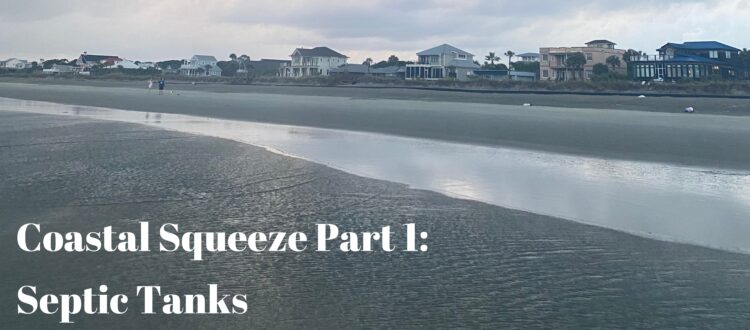Coastal Squeeze: Septic Tanks
The Charleston area has long struggled with bacteria pollution in its waterways. Now, our local communities and sewage infrastructure face a new threat: coastal squeeze.
Coastal squeeze occurs when development moves closer and closer to the shoreline while rising sea levels encroach into coastal communities. This reduces the natural buffer between communities and the water, putting pressure on local infrastructure to withstand the impacts of a changing climate. At the same time, coastal ecosystems like native forests, sand dunes, freshwater wetlands, and salt marshes are losing their ability to protect against storms and floods.

Rapid Population Growth and Development
The pressure from land and water makes it even harder to tackle the region’s sewage issues. Aggressive development, weak septic system regulations, flooding, and a race against sinking high ground and rising water levels compound the problem.
Charleston’s population has exploded. What was once forest and rural coastline is now covered with waterfront properties and suburban developments. The region’s population is growing three times faster than the national average. That growth is largely supported by dense clusters of individual septic tanks. Between 2018 and 2023, South Carolina issued 16,000 new septic system permits, primarily in Charleston County, while sea levels continue to rise about an inch every two years.

Despite efforts by James Island and Mount Pleasant to stop septic tank pollution, large-scale developments threaten future septic tank pollution resulting in bacteria and pathogens in our waterways. In Awendaw, for example, plans for a high-density residential development near Cape Romain will require installation of 1000s of new septic systems. At the same time, in Berkeley County, some new developments have left residents with failing septic systems within just five years of installation.
Taking Legal Action
In 2022, Charleston Waterkeeper and the Coastal Conservation League, represented by the South Carolina Environmental Law Project (SCELP), sued the South Carolina Department of Environmental Services (SCDES) demanding that septic tank permits in coastal areas be reviewed under the state’s Coastal Zone Management Act and to require public notice for all permit applications. This would give SCDES a more robust set of tools for septic tank permitting decisions allowing the agency to consider the cumulative impact of dense clusters of septic tanks on the state’s coastal marshes, wetlands, and waterways. The case is still pending in state court.
Rising Seas
South Carolina’s septic tank regulations fall short of addressing the local environmental challenges exacerbated by coastal squeeze. As it stands, sea level rise and more frequent flooding means septic systems are more likely to fail, leading to more bacteria in our waterways.
Coastal squeeze puts high density septic tank development at the center of a serious water quality challenge. It highlights the urgent need for stricter regulations and better oversight of septic systems in South Carolina’s coastal communities to protect and restore our waterways for future generations.
You can take action to help prevent current and future septic tank pollution!
Talk to your state and local elected officials about septic tanks and bacteria pollution. Ask them to support action that (1) supports smart planning tying growth to the availability of public sewer, (2) improves state regulations, especially vertical separation distance and minimum lot size requirements, and (3) requires SCDES to use the state’s coastal zone rules for permitting decisions in coastal counties.
If you have a septic tank, have it inspected by a professional, regularly maintained, and pumped out to ensure it is working properly.
Know before you go. Check Charleston Waterkeeper’s Swim Alert data to see where it’s safe to swim.
Want to learn more? Read this…
References
Coastal Flood Event Database. (n.d.). National Weather Service, NOAA. Retrieved August 26, 2024, from https://www.weather.gov/chs/coastalflood
Defeo, O., McLachlan, A., Armitage, D., Elliott, M., & Pittman, J. (2021). Sandy beach social–ecological systems at risk: regime shifts, collapses, and governance challenges. In Frontiers in Ecology and the Environment (Vol. 19, Issue 10, pp. 564–573). John Wiley and Sons Inc. https://doi.org/10.1002/fee.2406
Dennis, B., Crowe, K., Muyskens, J., & Chickwendiu, J. (2024, May 22). A Hidden Threat: Fast-rising seas could swamp septic systems in part of the South. Washington Post. https://www.washingtonpost.com/climate-environment/interactive/2024/septic-tanks-rising-waters-environment-health/
Egger, R., & Wunderley, A. (2023, June 18). Commentary: Best time to prevent septic tank pollution is before the tank is installed. Post and Courier. https://www.postandcourier.com/opinion/commentary/commentary-best-time-to-prevent-septic-tank-pollution-is-before-the-tank-is-installed/article_2ce02b4e-0a0c-11ee-bab6-135a6f6dba79.html
Population & Demographics. (n.d.). Charleston Regional Development . Retrieved August 26, 2024, from https://www.crda.org/local-data/population-demographics/
Ramsey, J. (2024, May 12). Failing septic tanks are polluting the SC coast. Thousands more are going in the ground. Post and Courier. https://www.postandcourier.com/news/septic-tank-failures-coastal-south-carolina/article_6cfbdcda-c6a1-11ee-aa80-d3f4019351fc.html
Sea Level Trends. (n.d.). NOAA Tides & Currents. Retrieved August 26, 2024, from https://tidesandcurrents.noaa.gov/sltrends/sltrends_station.shtml?id=8665530
Stumpf, C. H., Peeler, M. F., Thomas, S., & Noble, R. T. (2010). Loading of fecal indicator bacteria in North Carolina tidal creek headwaters: Hydrographic patterns and terrestrial runoff relationships. Water Research, 44(16). https://www.sciencedirect.com/science/article/abs/pii/S0043135410004720?casa_token=F8m16o7gKvAAAAAA:Qg6mbeU-mvn5uSm5xj2uvKaOPAP2zBzd1GqaZQBUpG3Bb1Z20JY3rS6768Mapn05yO1NlKHeHQ
Swim Alert. (n.d.). Charleston Waterkeeper. Retrieved August 26, 2024, from https://charlestonwaterkeeper.org/swimalert/Voiland, A. (n.d.). Rising Seas in Charleston. NASA Earth Observatory. Retrieved August 26, 2024, from https://earthobservatory.nasa.gov/images/147761/rising-seas-in-charleston

